Management Accounting Techniques, Planning, and Financial Problems
VerifiedAdded on 2023/01/12
|16
|3470
|91
Report
AI Summary
This report delves into the core principles of management accounting within a business context, focusing on the role of a managerial accountant. It includes detailed cost calculations using both marginal and absorption costing methods, highlighting their respective advantages and significance through the creation of income statements. The report also addresses common financial challenges faced by managerial accountants and proposes solutions using various costing management techniques. Furthermore, it explores accounting finance tools and techniques for budgeting and sales forecasting, emphasizing the importance of key performance indicators (KPIs) in measuring actual performance. The concept of sustainable success is discussed, underscoring its importance for firms and its contribution to net worth.
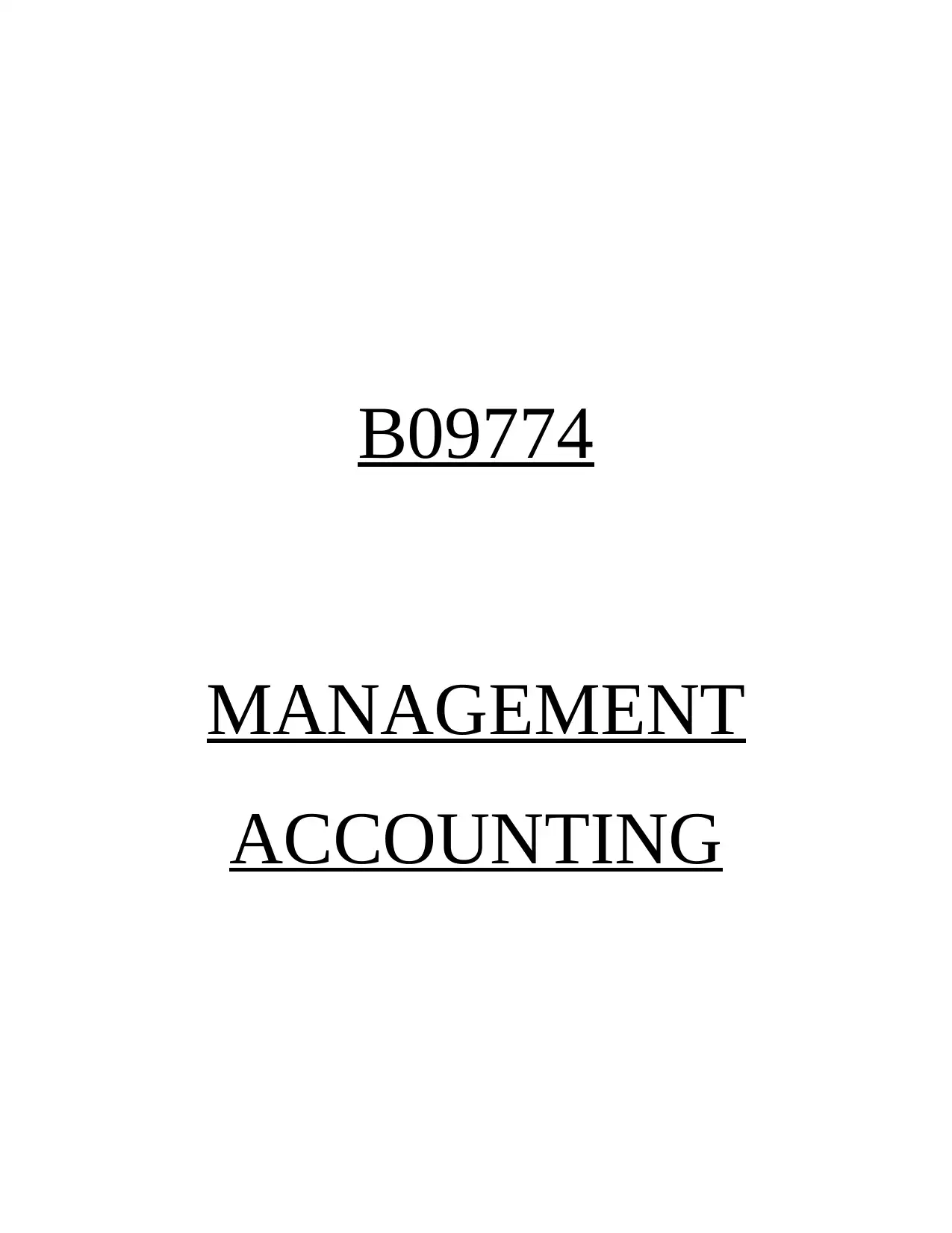
B09774
MANAGEMENT
ACCOUNTING
MANAGEMENT
ACCOUNTING
Paraphrase This Document
Need a fresh take? Get an instant paraphrase of this document with our AI Paraphraser
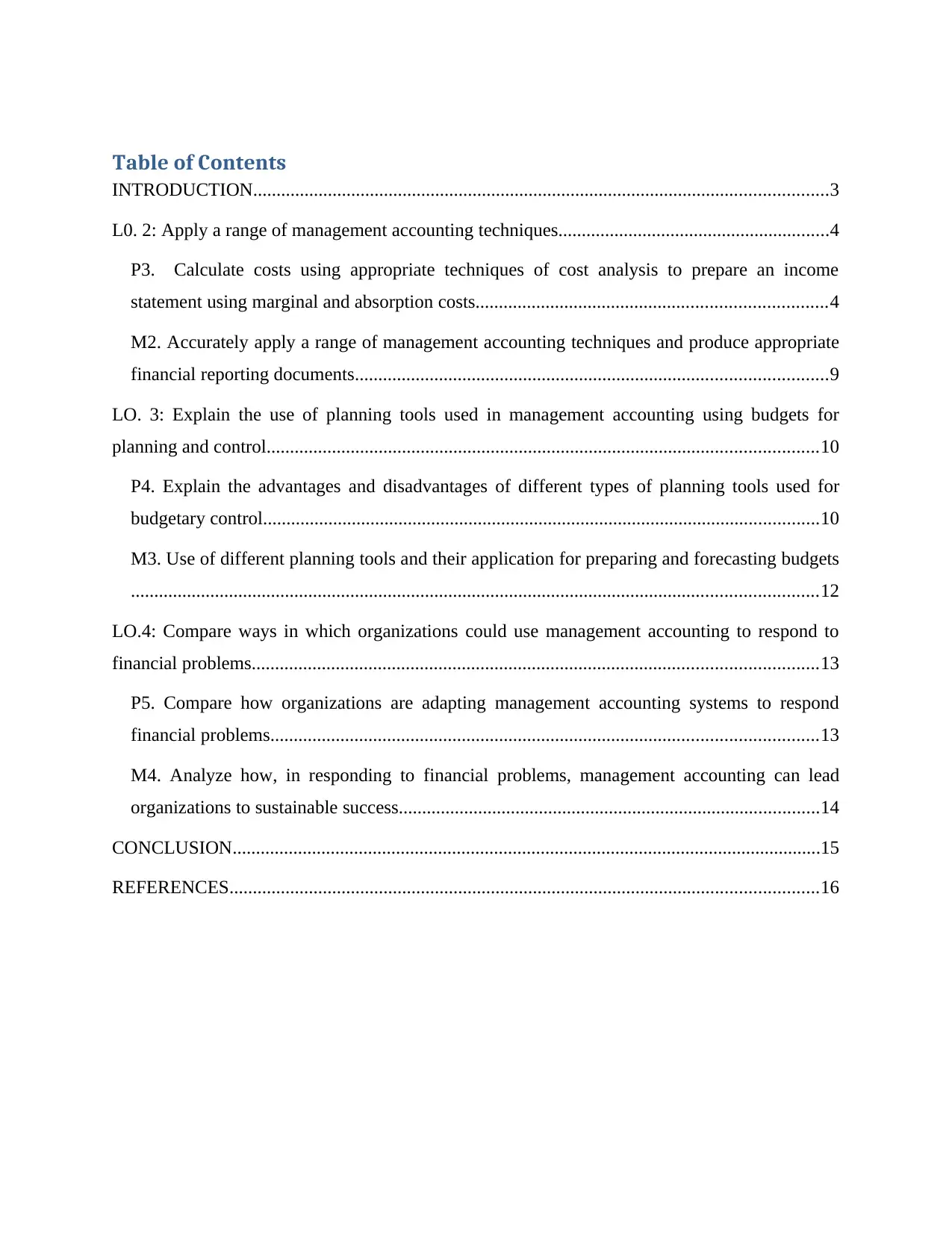
Table of Contents
INTRODUCTION...........................................................................................................................3
L0. 2: Apply a range of management accounting techniques..........................................................4
P3. Calculate costs using appropriate techniques of cost analysis to prepare an income
statement using marginal and absorption costs...........................................................................4
M2. Accurately apply a range of management accounting techniques and produce appropriate
financial reporting documents.....................................................................................................9
LO. 3: Explain the use of planning tools used in management accounting using budgets for
planning and control......................................................................................................................10
P4. Explain the advantages and disadvantages of different types of planning tools used for
budgetary control.......................................................................................................................10
M3. Use of different planning tools and their application for preparing and forecasting budgets
...................................................................................................................................................12
LO.4: Compare ways in which organizations could use management accounting to respond to
financial problems.........................................................................................................................13
P5. Compare how organizations are adapting management accounting systems to respond
financial problems.....................................................................................................................13
M4. Analyze how, in responding to financial problems, management accounting can lead
organizations to sustainable success..........................................................................................14
CONCLUSION..............................................................................................................................15
REFERENCES..............................................................................................................................16
INTRODUCTION...........................................................................................................................3
L0. 2: Apply a range of management accounting techniques..........................................................4
P3. Calculate costs using appropriate techniques of cost analysis to prepare an income
statement using marginal and absorption costs...........................................................................4
M2. Accurately apply a range of management accounting techniques and produce appropriate
financial reporting documents.....................................................................................................9
LO. 3: Explain the use of planning tools used in management accounting using budgets for
planning and control......................................................................................................................10
P4. Explain the advantages and disadvantages of different types of planning tools used for
budgetary control.......................................................................................................................10
M3. Use of different planning tools and their application for preparing and forecasting budgets
...................................................................................................................................................12
LO.4: Compare ways in which organizations could use management accounting to respond to
financial problems.........................................................................................................................13
P5. Compare how organizations are adapting management accounting systems to respond
financial problems.....................................................................................................................13
M4. Analyze how, in responding to financial problems, management accounting can lead
organizations to sustainable success..........................................................................................14
CONCLUSION..............................................................................................................................15
REFERENCES..............................................................................................................................16
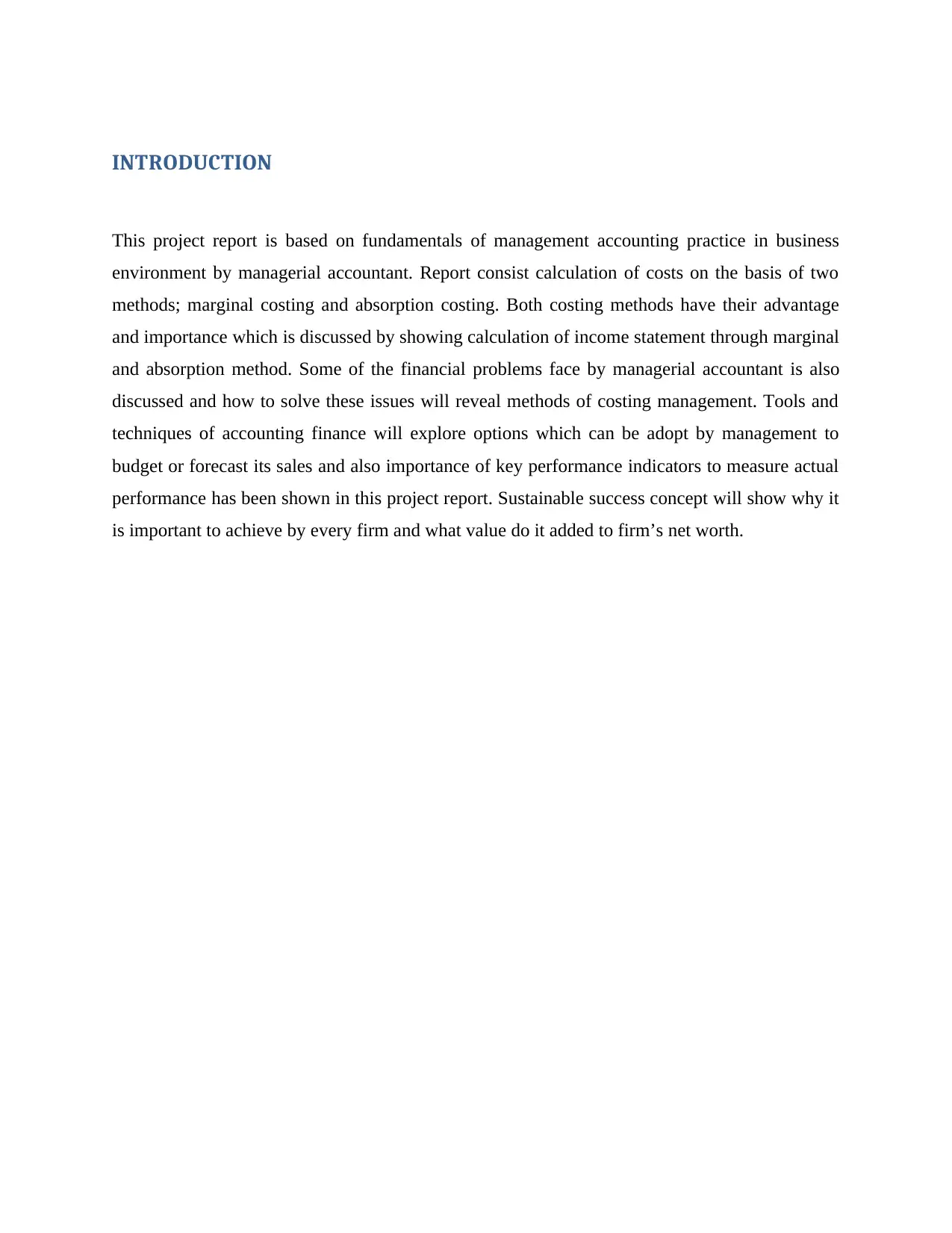
INTRODUCTION
This project report is based on fundamentals of management accounting practice in business
environment by managerial accountant. Report consist calculation of costs on the basis of two
methods; marginal costing and absorption costing. Both costing methods have their advantage
and importance which is discussed by showing calculation of income statement through marginal
and absorption method. Some of the financial problems face by managerial accountant is also
discussed and how to solve these issues will reveal methods of costing management. Tools and
techniques of accounting finance will explore options which can be adopt by management to
budget or forecast its sales and also importance of key performance indicators to measure actual
performance has been shown in this project report. Sustainable success concept will show why it
is important to achieve by every firm and what value do it added to firm’s net worth.
This project report is based on fundamentals of management accounting practice in business
environment by managerial accountant. Report consist calculation of costs on the basis of two
methods; marginal costing and absorption costing. Both costing methods have their advantage
and importance which is discussed by showing calculation of income statement through marginal
and absorption method. Some of the financial problems face by managerial accountant is also
discussed and how to solve these issues will reveal methods of costing management. Tools and
techniques of accounting finance will explore options which can be adopt by management to
budget or forecast its sales and also importance of key performance indicators to measure actual
performance has been shown in this project report. Sustainable success concept will show why it
is important to achieve by every firm and what value do it added to firm’s net worth.
⊘ This is a preview!⊘
Do you want full access?
Subscribe today to unlock all pages.

Trusted by 1+ million students worldwide
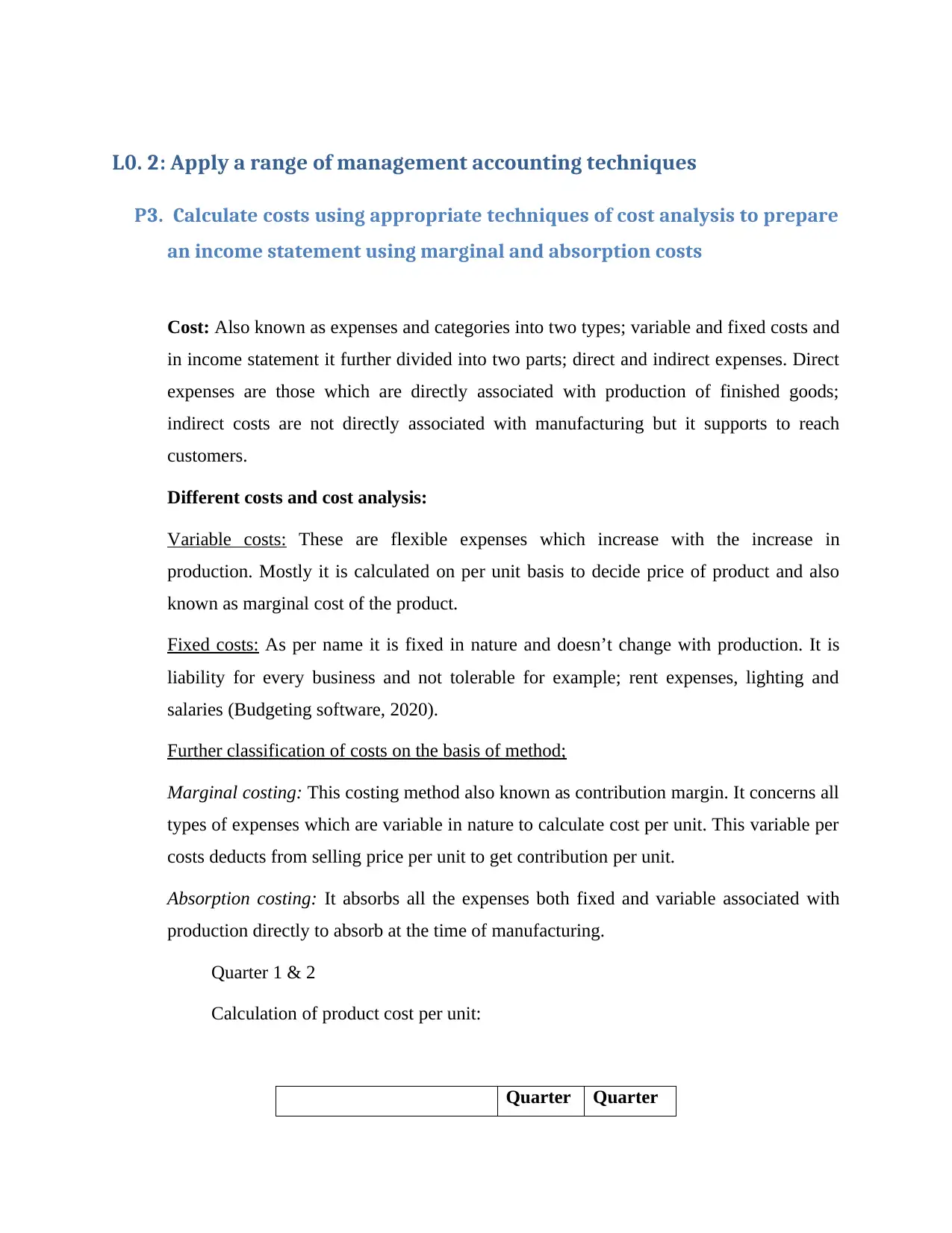
L0. 2: Apply a range of management accounting techniques
P3. Calculate costs using appropriate techniques of cost analysis to prepare
an income statement using marginal and absorption costs
Cost: Also known as expenses and categories into two types; variable and fixed costs and
in income statement it further divided into two parts; direct and indirect expenses. Direct
expenses are those which are directly associated with production of finished goods;
indirect costs are not directly associated with manufacturing but it supports to reach
customers.
Different costs and cost analysis:
Variable costs: These are flexible expenses which increase with the increase in
production. Mostly it is calculated on per unit basis to decide price of product and also
known as marginal cost of the product.
Fixed costs: As per name it is fixed in nature and doesn’t change with production. It is
liability for every business and not tolerable for example; rent expenses, lighting and
salaries (Budgeting software, 2020).
Further classification of costs on the basis of method;
Marginal costing: This costing method also known as contribution margin. It concerns all
types of expenses which are variable in nature to calculate cost per unit. This variable per
costs deducts from selling price per unit to get contribution per unit.
Absorption costing: It absorbs all the expenses both fixed and variable associated with
production directly to absorb at the time of manufacturing.
Quarter 1 & 2
Calculation of product cost per unit:
Quarter Quarter
P3. Calculate costs using appropriate techniques of cost analysis to prepare
an income statement using marginal and absorption costs
Cost: Also known as expenses and categories into two types; variable and fixed costs and
in income statement it further divided into two parts; direct and indirect expenses. Direct
expenses are those which are directly associated with production of finished goods;
indirect costs are not directly associated with manufacturing but it supports to reach
customers.
Different costs and cost analysis:
Variable costs: These are flexible expenses which increase with the increase in
production. Mostly it is calculated on per unit basis to decide price of product and also
known as marginal cost of the product.
Fixed costs: As per name it is fixed in nature and doesn’t change with production. It is
liability for every business and not tolerable for example; rent expenses, lighting and
salaries (Budgeting software, 2020).
Further classification of costs on the basis of method;
Marginal costing: This costing method also known as contribution margin. It concerns all
types of expenses which are variable in nature to calculate cost per unit. This variable per
costs deducts from selling price per unit to get contribution per unit.
Absorption costing: It absorbs all the expenses both fixed and variable associated with
production directly to absorb at the time of manufacturing.
Quarter 1 & 2
Calculation of product cost per unit:
Quarter Quarter
Paraphrase This Document
Need a fresh take? Get an instant paraphrase of this document with our AI Paraphraser
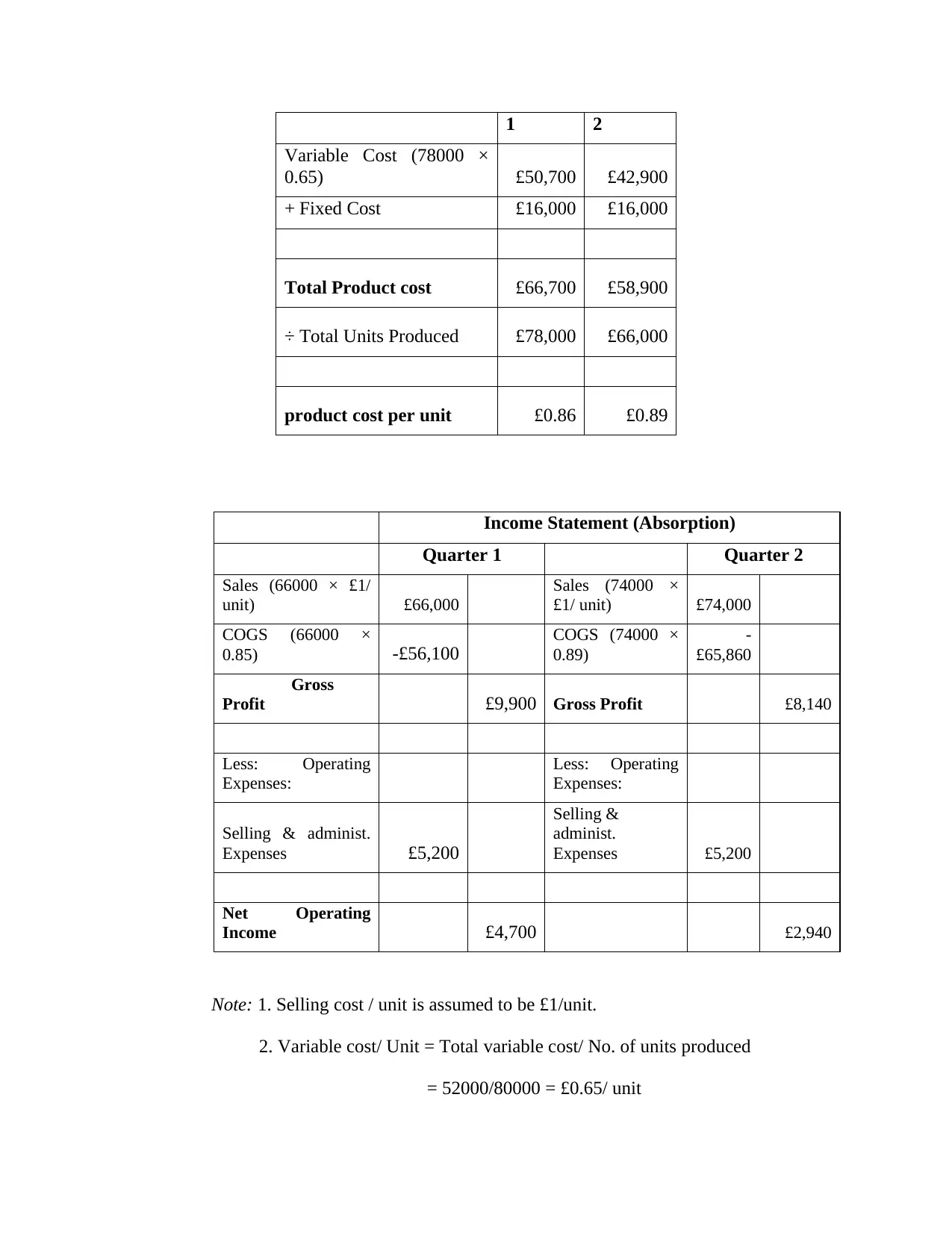
1 2
Variable Cost (78000 ×
0.65) £50,700 £42,900
+ Fixed Cost £16,000 £16,000
Total Product cost £66,700 £58,900
÷ Total Units Produced £78,000 £66,000
product cost per unit £0.86 £0.89
Income Statement (Absorption)
Quarter 1 Quarter 2
Sales (66000 × £1/
unit) £66,000
Sales (74000 ×
£1/ unit) £74,000
COGS (66000 ×
0.85) -£56,100
COGS (74000 ×
0.89)
-
£65,860
Gross
Profit £9,900 Gross Profit £8,140
Less: Operating
Expenses:
Less: Operating
Expenses:
Selling & administ.
Expenses £5,200
Selling &
administ.
Expenses £5,200
Net Operating
Income £4,700 £2,940
Note: 1. Selling cost / unit is assumed to be £1/unit.
2. Variable cost/ Unit = Total variable cost/ No. of units produced
= 52000/80000 = £0.65/ unit
Variable Cost (78000 ×
0.65) £50,700 £42,900
+ Fixed Cost £16,000 £16,000
Total Product cost £66,700 £58,900
÷ Total Units Produced £78,000 £66,000
product cost per unit £0.86 £0.89
Income Statement (Absorption)
Quarter 1 Quarter 2
Sales (66000 × £1/
unit) £66,000
Sales (74000 ×
£1/ unit) £74,000
COGS (66000 ×
0.85) -£56,100
COGS (74000 ×
0.89)
-
£65,860
Gross
Profit £9,900 Gross Profit £8,140
Less: Operating
Expenses:
Less: Operating
Expenses:
Selling & administ.
Expenses £5,200
Selling &
administ.
Expenses £5,200
Net Operating
Income £4,700 £2,940
Note: 1. Selling cost / unit is assumed to be £1/unit.
2. Variable cost/ Unit = Total variable cost/ No. of units produced
= 52000/80000 = £0.65/ unit
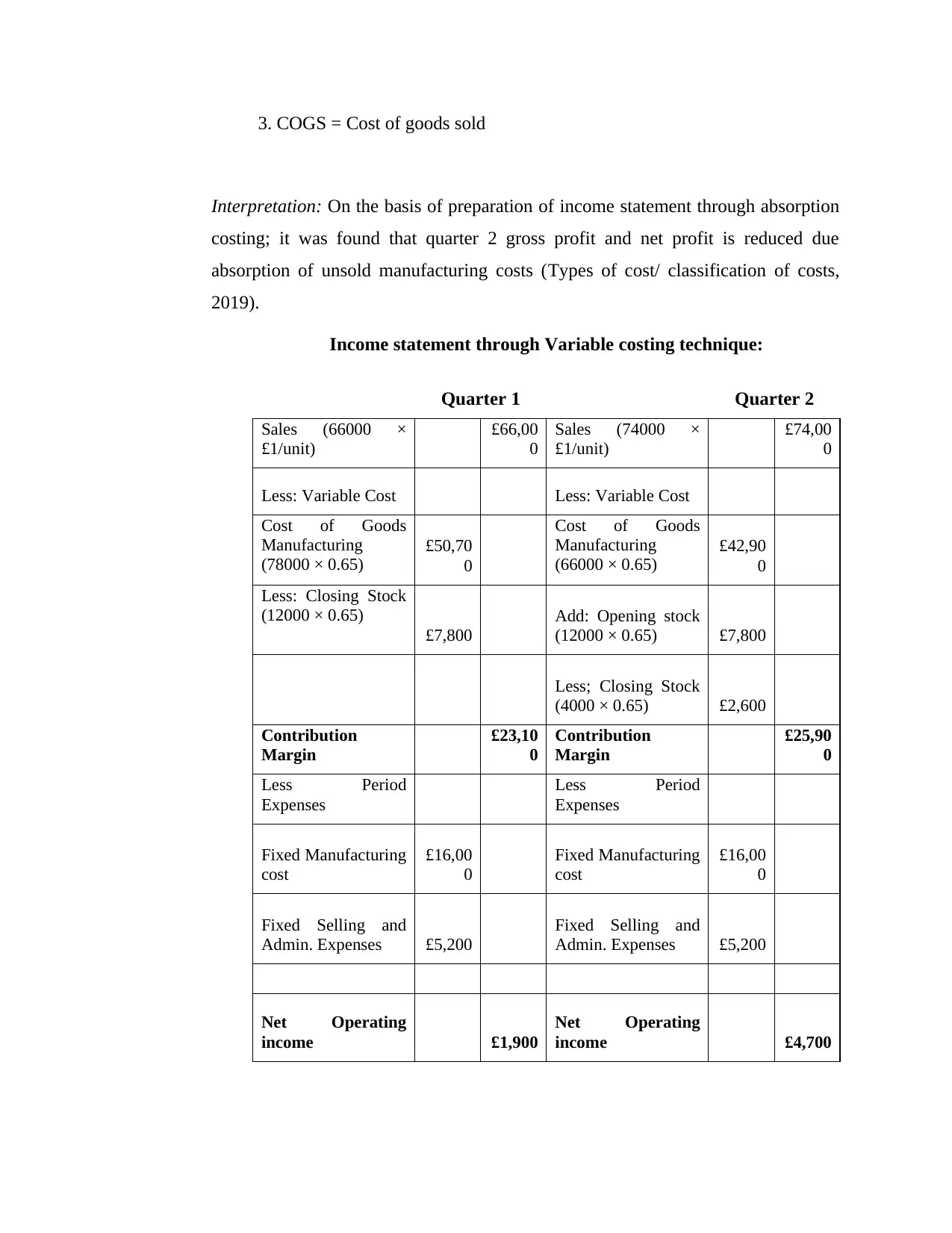
3. COGS = Cost of goods sold
Interpretation: On the basis of preparation of income statement through absorption
costing; it was found that quarter 2 gross profit and net profit is reduced due
absorption of unsold manufacturing costs (Types of cost/ classification of costs,
2019).
Income statement through Variable costing technique:
Quarter 1 Quarter 2
Sales (66000 ×
£1/unit)
£66,00
0
Sales (74000 ×
£1/unit)
£74,00
0
Less: Variable Cost Less: Variable Cost
Cost of Goods
Manufacturing
(78000 × 0.65)
£50,70
0
Cost of Goods
Manufacturing
(66000 × 0.65)
£42,90
0
Less: Closing Stock
(12000 × 0.65)
£7,800
Add: Opening stock
(12000 × 0.65) £7,800
Less; Closing Stock
(4000 × 0.65) £2,600
Contribution
Margin
£23,10
0
Contribution
Margin
£25,90
0
Less Period
Expenses
Less Period
Expenses
Fixed Manufacturing
cost
£16,00
0
Fixed Manufacturing
cost
£16,00
0
Fixed Selling and
Admin. Expenses £5,200
Fixed Selling and
Admin. Expenses £5,200
Net Operating
income £1,900
Net Operating
income £4,700
Interpretation: On the basis of preparation of income statement through absorption
costing; it was found that quarter 2 gross profit and net profit is reduced due
absorption of unsold manufacturing costs (Types of cost/ classification of costs,
2019).
Income statement through Variable costing technique:
Quarter 1 Quarter 2
Sales (66000 ×
£1/unit)
£66,00
0
Sales (74000 ×
£1/unit)
£74,00
0
Less: Variable Cost Less: Variable Cost
Cost of Goods
Manufacturing
(78000 × 0.65)
£50,70
0
Cost of Goods
Manufacturing
(66000 × 0.65)
£42,90
0
Less: Closing Stock
(12000 × 0.65)
£7,800
Add: Opening stock
(12000 × 0.65) £7,800
Less; Closing Stock
(4000 × 0.65) £2,600
Contribution
Margin
£23,10
0
Contribution
Margin
£25,90
0
Less Period
Expenses
Less Period
Expenses
Fixed Manufacturing
cost
£16,00
0
Fixed Manufacturing
cost
£16,00
0
Fixed Selling and
Admin. Expenses £5,200
Fixed Selling and
Admin. Expenses £5,200
Net Operating
income £1,900
Net Operating
income £4,700
⊘ This is a preview!⊘
Do you want full access?
Subscribe today to unlock all pages.

Trusted by 1+ million students worldwide
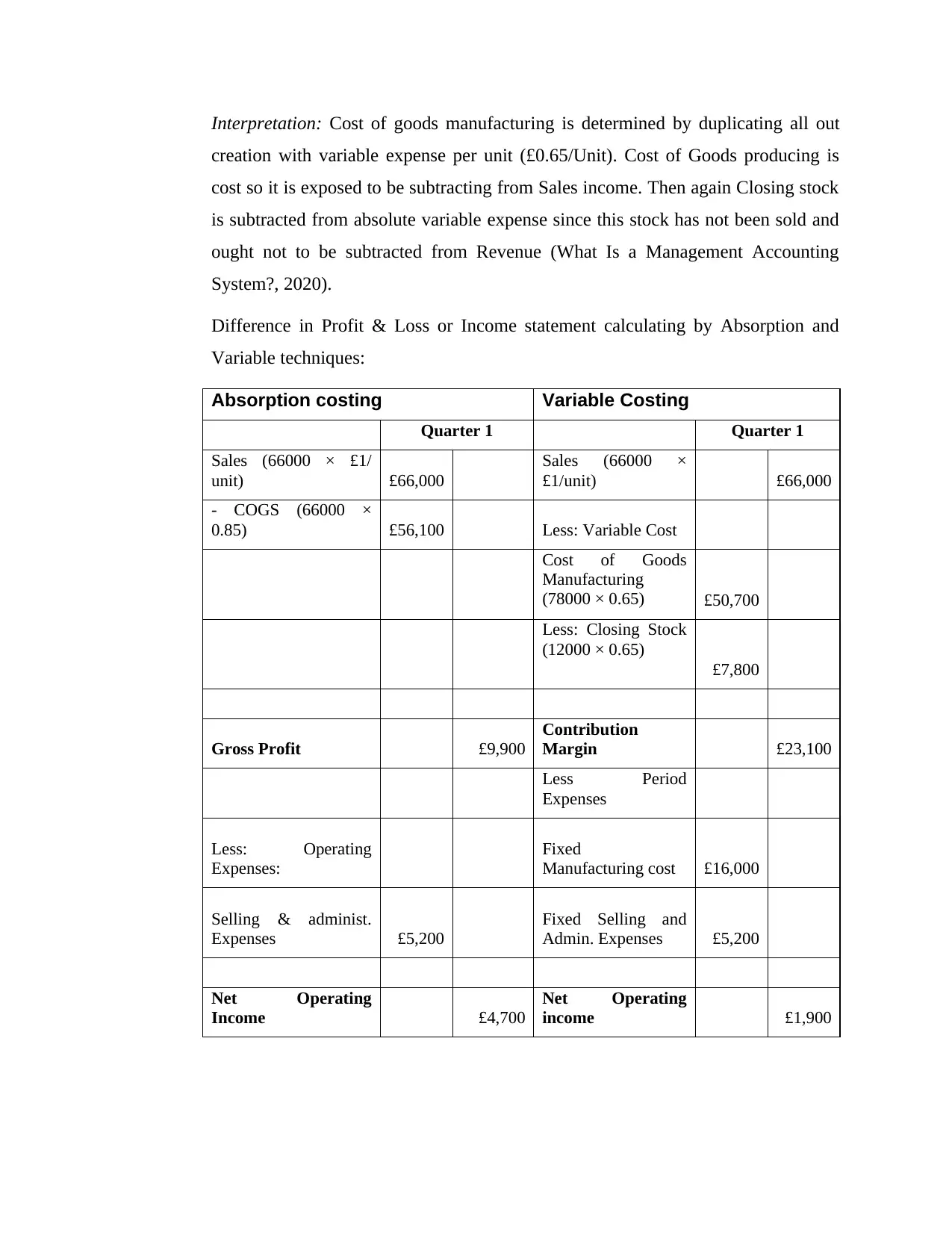
Interpretation: Cost of goods manufacturing is determined by duplicating all out
creation with variable expense per unit (£0.65/Unit). Cost of Goods producing is
cost so it is exposed to be subtracting from Sales income. Then again Closing stock
is subtracted from absolute variable expense since this stock has not been sold and
ought not to be subtracted from Revenue (What Is a Management Accounting
System?, 2020).
Difference in Profit & Loss or Income statement calculating by Absorption and
Variable techniques:
Absorption costing Variable Costing
Quarter 1 Quarter 1
Sales (66000 × £1/
unit) £66,000
Sales (66000 ×
£1/unit) £66,000
- COGS (66000 ×
0.85) £56,100 Less: Variable Cost
Cost of Goods
Manufacturing
(78000 × 0.65) £50,700
Less: Closing Stock
(12000 × 0.65)
£7,800
Gross Profit £9,900
Contribution
Margin £23,100
Less Period
Expenses
Less: Operating
Expenses:
Fixed
Manufacturing cost £16,000
Selling & administ.
Expenses £5,200
Fixed Selling and
Admin. Expenses £5,200
Net Operating
Income £4,700
Net Operating
income £1,900
creation with variable expense per unit (£0.65/Unit). Cost of Goods producing is
cost so it is exposed to be subtracting from Sales income. Then again Closing stock
is subtracted from absolute variable expense since this stock has not been sold and
ought not to be subtracted from Revenue (What Is a Management Accounting
System?, 2020).
Difference in Profit & Loss or Income statement calculating by Absorption and
Variable techniques:
Absorption costing Variable Costing
Quarter 1 Quarter 1
Sales (66000 × £1/
unit) £66,000
Sales (66000 ×
£1/unit) £66,000
- COGS (66000 ×
0.85) £56,100 Less: Variable Cost
Cost of Goods
Manufacturing
(78000 × 0.65) £50,700
Less: Closing Stock
(12000 × 0.65)
£7,800
Gross Profit £9,900
Contribution
Margin £23,100
Less Period
Expenses
Less: Operating
Expenses:
Fixed
Manufacturing cost £16,000
Selling & administ.
Expenses £5,200
Fixed Selling and
Admin. Expenses £5,200
Net Operating
Income £4,700
Net Operating
income £1,900
Paraphrase This Document
Need a fresh take? Get an instant paraphrase of this document with our AI Paraphraser
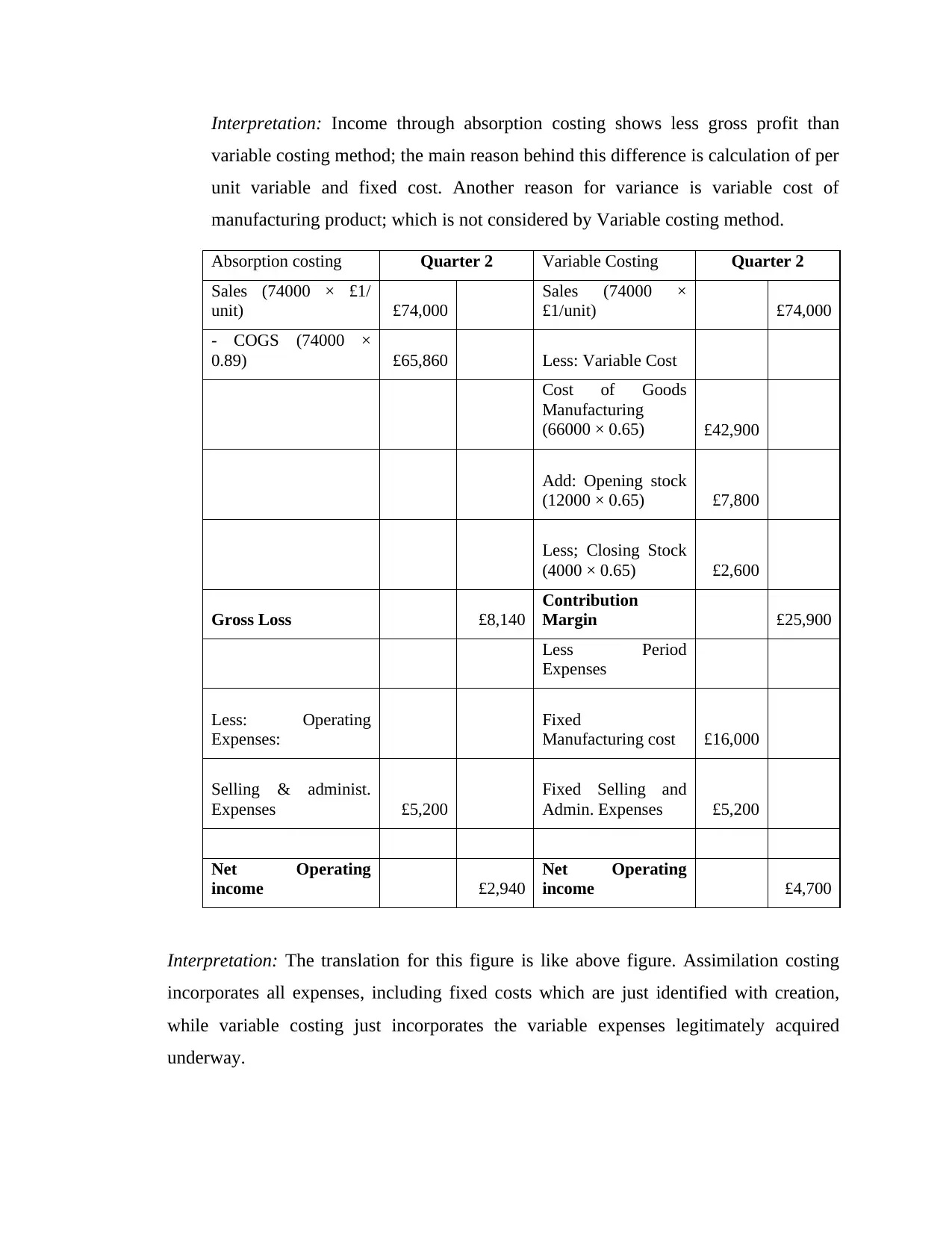
Interpretation: Income through absorption costing shows less gross profit than
variable costing method; the main reason behind this difference is calculation of per
unit variable and fixed cost. Another reason for variance is variable cost of
manufacturing product; which is not considered by Variable costing method.
Absorption costing Quarter 2 Variable Costing Quarter 2
Sales (74000 × £1/
unit) £74,000
Sales (74000 ×
£1/unit) £74,000
- COGS (74000 ×
0.89) £65,860 Less: Variable Cost
Cost of Goods
Manufacturing
(66000 × 0.65) £42,900
Add: Opening stock
(12000 × 0.65) £7,800
Less; Closing Stock
(4000 × 0.65) £2,600
Gross Loss £8,140
Contribution
Margin £25,900
Less Period
Expenses
Less: Operating
Expenses:
Fixed
Manufacturing cost £16,000
Selling & administ.
Expenses £5,200
Fixed Selling and
Admin. Expenses £5,200
Net Operating
income £2,940
Net Operating
income £4,700
Interpretation: The translation for this figure is like above figure. Assimilation costing
incorporates all expenses, including fixed costs which are just identified with creation,
while variable costing just incorporates the variable expenses legitimately acquired
underway.
variable costing method; the main reason behind this difference is calculation of per
unit variable and fixed cost. Another reason for variance is variable cost of
manufacturing product; which is not considered by Variable costing method.
Absorption costing Quarter 2 Variable Costing Quarter 2
Sales (74000 × £1/
unit) £74,000
Sales (74000 ×
£1/unit) £74,000
- COGS (74000 ×
0.89) £65,860 Less: Variable Cost
Cost of Goods
Manufacturing
(66000 × 0.65) £42,900
Add: Opening stock
(12000 × 0.65) £7,800
Less; Closing Stock
(4000 × 0.65) £2,600
Gross Loss £8,140
Contribution
Margin £25,900
Less Period
Expenses
Less: Operating
Expenses:
Fixed
Manufacturing cost £16,000
Selling & administ.
Expenses £5,200
Fixed Selling and
Admin. Expenses £5,200
Net Operating
income £2,940
Net Operating
income £4,700
Interpretation: The translation for this figure is like above figure. Assimilation costing
incorporates all expenses, including fixed costs which are just identified with creation,
while variable costing just incorporates the variable expenses legitimately acquired
underway.
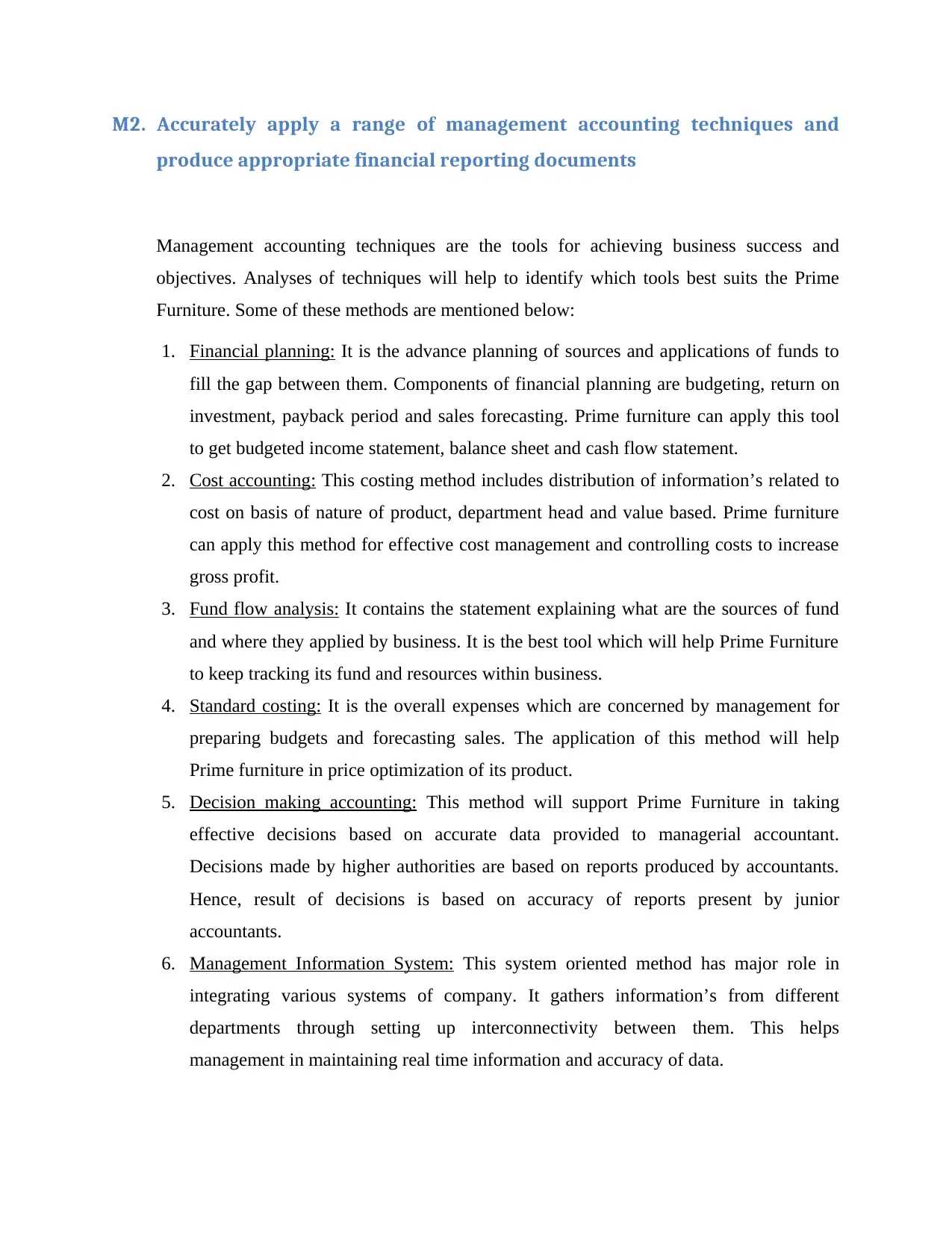
M2. Accurately apply a range of management accounting techniques and
produce appropriate financial reporting documents
Management accounting techniques are the tools for achieving business success and
objectives. Analyses of techniques will help to identify which tools best suits the Prime
Furniture. Some of these methods are mentioned below:
1. Financial planning: It is the advance planning of sources and applications of funds to
fill the gap between them. Components of financial planning are budgeting, return on
investment, payback period and sales forecasting. Prime furniture can apply this tool
to get budgeted income statement, balance sheet and cash flow statement.
2. Cost accounting: This costing method includes distribution of information’s related to
cost on basis of nature of product, department head and value based. Prime furniture
can apply this method for effective cost management and controlling costs to increase
gross profit.
3. Fund flow analysis: It contains the statement explaining what are the sources of fund
and where they applied by business. It is the best tool which will help Prime Furniture
to keep tracking its fund and resources within business.
4. Standard costing: It is the overall expenses which are concerned by management for
preparing budgets and forecasting sales. The application of this method will help
Prime furniture in price optimization of its product.
5. Decision making accounting: This method will support Prime Furniture in taking
effective decisions based on accurate data provided to managerial accountant.
Decisions made by higher authorities are based on reports produced by accountants.
Hence, result of decisions is based on accuracy of reports present by junior
accountants.
6. Management Information System: This system oriented method has major role in
integrating various systems of company. It gathers information’s from different
departments through setting up interconnectivity between them. This helps
management in maintaining real time information and accuracy of data.
produce appropriate financial reporting documents
Management accounting techniques are the tools for achieving business success and
objectives. Analyses of techniques will help to identify which tools best suits the Prime
Furniture. Some of these methods are mentioned below:
1. Financial planning: It is the advance planning of sources and applications of funds to
fill the gap between them. Components of financial planning are budgeting, return on
investment, payback period and sales forecasting. Prime furniture can apply this tool
to get budgeted income statement, balance sheet and cash flow statement.
2. Cost accounting: This costing method includes distribution of information’s related to
cost on basis of nature of product, department head and value based. Prime furniture
can apply this method for effective cost management and controlling costs to increase
gross profit.
3. Fund flow analysis: It contains the statement explaining what are the sources of fund
and where they applied by business. It is the best tool which will help Prime Furniture
to keep tracking its fund and resources within business.
4. Standard costing: It is the overall expenses which are concerned by management for
preparing budgets and forecasting sales. The application of this method will help
Prime furniture in price optimization of its product.
5. Decision making accounting: This method will support Prime Furniture in taking
effective decisions based on accurate data provided to managerial accountant.
Decisions made by higher authorities are based on reports produced by accountants.
Hence, result of decisions is based on accuracy of reports present by junior
accountants.
6. Management Information System: This system oriented method has major role in
integrating various systems of company. It gathers information’s from different
departments through setting up interconnectivity between them. This helps
management in maintaining real time information and accuracy of data.
⊘ This is a preview!⊘
Do you want full access?
Subscribe today to unlock all pages.

Trusted by 1+ million students worldwide
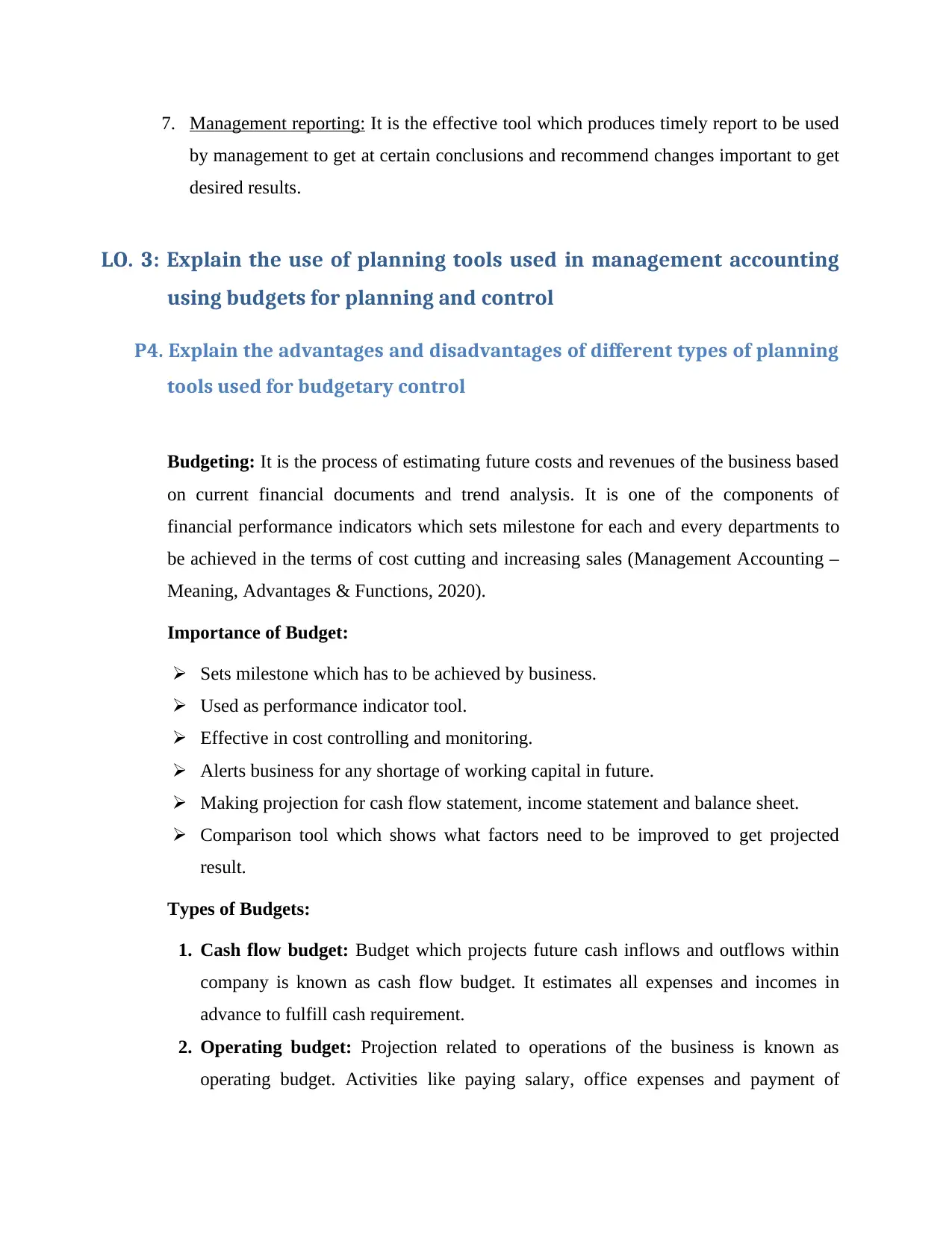
7. Management reporting: It is the effective tool which produces timely report to be used
by management to get at certain conclusions and recommend changes important to get
desired results.
LO. 3: Explain the use of planning tools used in management accounting
using budgets for planning and control
P4. Explain the advantages and disadvantages of different types of planning
tools used for budgetary control
Budgeting: It is the process of estimating future costs and revenues of the business based
on current financial documents and trend analysis. It is one of the components of
financial performance indicators which sets milestone for each and every departments to
be achieved in the terms of cost cutting and increasing sales (Management Accounting –
Meaning, Advantages & Functions, 2020).
Importance of Budget:
Sets milestone which has to be achieved by business.
Used as performance indicator tool.
Effective in cost controlling and monitoring.
Alerts business for any shortage of working capital in future.
Making projection for cash flow statement, income statement and balance sheet.
Comparison tool which shows what factors need to be improved to get projected
result.
Types of Budgets:
1. Cash flow budget: Budget which projects future cash inflows and outflows within
company is known as cash flow budget. It estimates all expenses and incomes in
advance to fulfill cash requirement.
2. Operating budget: Projection related to operations of the business is known as
operating budget. Activities like paying salary, office expenses and payment of
by management to get at certain conclusions and recommend changes important to get
desired results.
LO. 3: Explain the use of planning tools used in management accounting
using budgets for planning and control
P4. Explain the advantages and disadvantages of different types of planning
tools used for budgetary control
Budgeting: It is the process of estimating future costs and revenues of the business based
on current financial documents and trend analysis. It is one of the components of
financial performance indicators which sets milestone for each and every departments to
be achieved in the terms of cost cutting and increasing sales (Management Accounting –
Meaning, Advantages & Functions, 2020).
Importance of Budget:
Sets milestone which has to be achieved by business.
Used as performance indicator tool.
Effective in cost controlling and monitoring.
Alerts business for any shortage of working capital in future.
Making projection for cash flow statement, income statement and balance sheet.
Comparison tool which shows what factors need to be improved to get projected
result.
Types of Budgets:
1. Cash flow budget: Budget which projects future cash inflows and outflows within
company is known as cash flow budget. It estimates all expenses and incomes in
advance to fulfill cash requirement.
2. Operating budget: Projection related to operations of the business is known as
operating budget. Activities like paying salary, office expenses and payment of
Paraphrase This Document
Need a fresh take? Get an instant paraphrase of this document with our AI Paraphraser
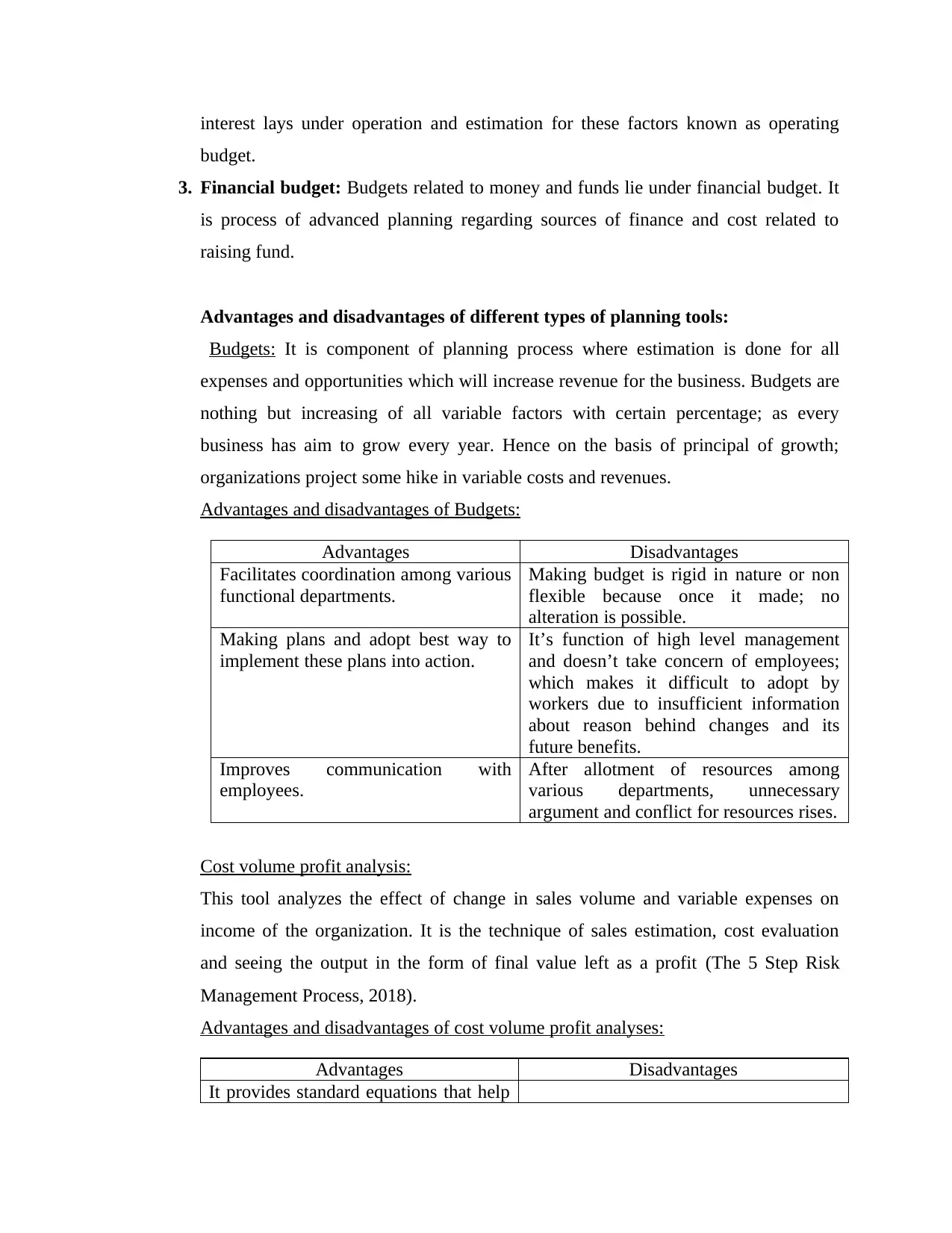
interest lays under operation and estimation for these factors known as operating
budget.
3. Financial budget: Budgets related to money and funds lie under financial budget. It
is process of advanced planning regarding sources of finance and cost related to
raising fund.
Advantages and disadvantages of different types of planning tools:
Budgets: It is component of planning process where estimation is done for all
expenses and opportunities which will increase revenue for the business. Budgets are
nothing but increasing of all variable factors with certain percentage; as every
business has aim to grow every year. Hence on the basis of principal of growth;
organizations project some hike in variable costs and revenues.
Advantages and disadvantages of Budgets:
Advantages Disadvantages
Facilitates coordination among various
functional departments.
Making budget is rigid in nature or non
flexible because once it made; no
alteration is possible.
Making plans and adopt best way to
implement these plans into action.
It’s function of high level management
and doesn’t take concern of employees;
which makes it difficult to adopt by
workers due to insufficient information
about reason behind changes and its
future benefits.
Improves communication with
employees.
After allotment of resources among
various departments, unnecessary
argument and conflict for resources rises.
Cost volume profit analysis:
This tool analyzes the effect of change in sales volume and variable expenses on
income of the organization. It is the technique of sales estimation, cost evaluation
and seeing the output in the form of final value left as a profit (The 5 Step Risk
Management Process, 2018).
Advantages and disadvantages of cost volume profit analyses:
Advantages Disadvantages
It provides standard equations that help
budget.
3. Financial budget: Budgets related to money and funds lie under financial budget. It
is process of advanced planning regarding sources of finance and cost related to
raising fund.
Advantages and disadvantages of different types of planning tools:
Budgets: It is component of planning process where estimation is done for all
expenses and opportunities which will increase revenue for the business. Budgets are
nothing but increasing of all variable factors with certain percentage; as every
business has aim to grow every year. Hence on the basis of principal of growth;
organizations project some hike in variable costs and revenues.
Advantages and disadvantages of Budgets:
Advantages Disadvantages
Facilitates coordination among various
functional departments.
Making budget is rigid in nature or non
flexible because once it made; no
alteration is possible.
Making plans and adopt best way to
implement these plans into action.
It’s function of high level management
and doesn’t take concern of employees;
which makes it difficult to adopt by
workers due to insufficient information
about reason behind changes and its
future benefits.
Improves communication with
employees.
After allotment of resources among
various departments, unnecessary
argument and conflict for resources rises.
Cost volume profit analysis:
This tool analyzes the effect of change in sales volume and variable expenses on
income of the organization. It is the technique of sales estimation, cost evaluation
and seeing the output in the form of final value left as a profit (The 5 Step Risk
Management Process, 2018).
Advantages and disadvantages of cost volume profit analyses:
Advantages Disadvantages
It provides standard equations that help
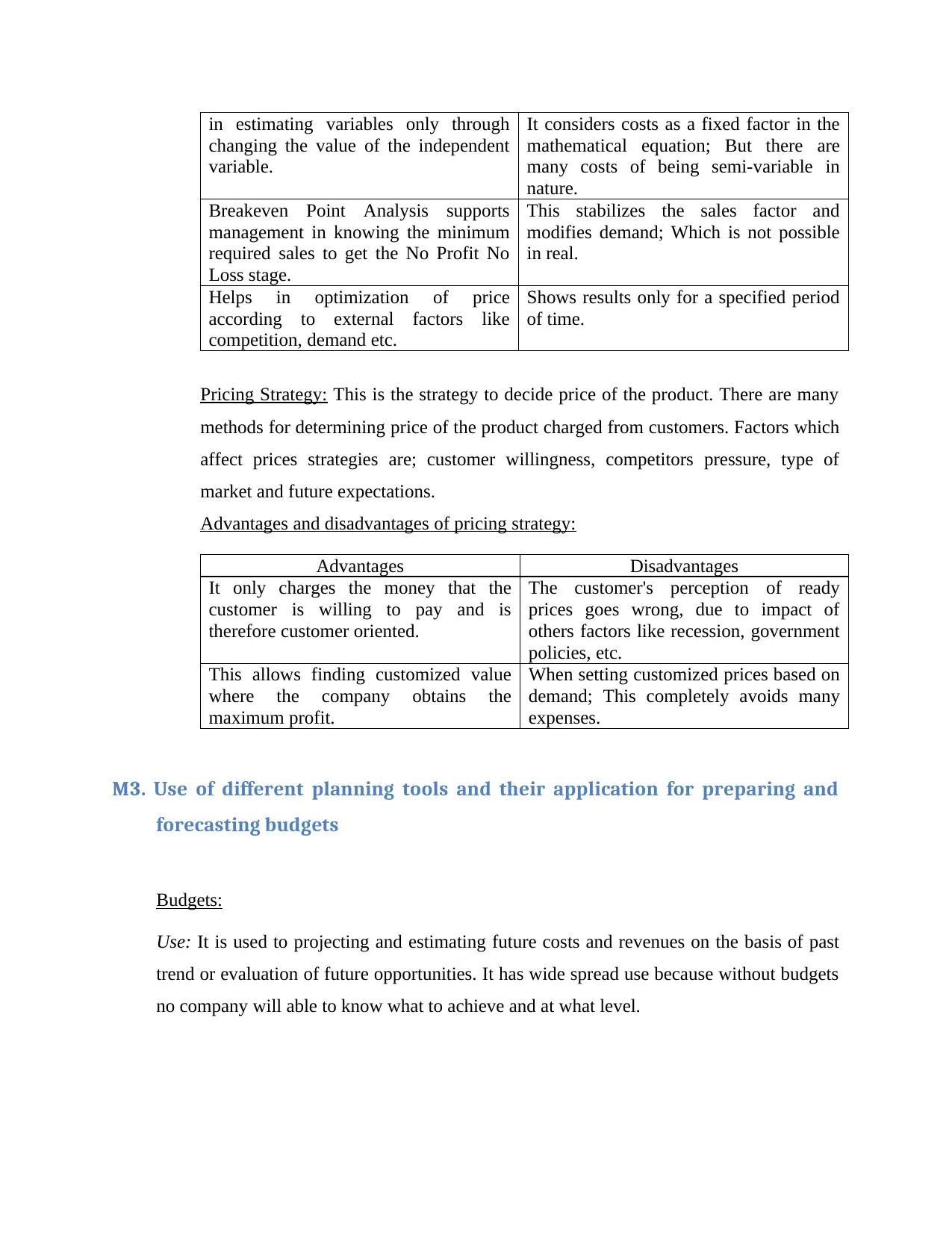
in estimating variables only through
changing the value of the independent
variable.
It considers costs as a fixed factor in the
mathematical equation; But there are
many costs of being semi-variable in
nature.
Breakeven Point Analysis supports
management in knowing the minimum
required sales to get the No Profit No
Loss stage.
This stabilizes the sales factor and
modifies demand; Which is not possible
in real.
Helps in optimization of price
according to external factors like
competition, demand etc.
Shows results only for a specified period
of time.
Pricing Strategy: This is the strategy to decide price of the product. There are many
methods for determining price of the product charged from customers. Factors which
affect prices strategies are; customer willingness, competitors pressure, type of
market and future expectations.
Advantages and disadvantages of pricing strategy:
Advantages Disadvantages
It only charges the money that the
customer is willing to pay and is
therefore customer oriented.
The customer's perception of ready
prices goes wrong, due to impact of
others factors like recession, government
policies, etc.
This allows finding customized value
where the company obtains the
maximum profit.
When setting customized prices based on
demand; This completely avoids many
expenses.
M3. Use of different planning tools and their application for preparing and
forecasting budgets
Budgets:
Use: It is used to projecting and estimating future costs and revenues on the basis of past
trend or evaluation of future opportunities. It has wide spread use because without budgets
no company will able to know what to achieve and at what level.
changing the value of the independent
variable.
It considers costs as a fixed factor in the
mathematical equation; But there are
many costs of being semi-variable in
nature.
Breakeven Point Analysis supports
management in knowing the minimum
required sales to get the No Profit No
Loss stage.
This stabilizes the sales factor and
modifies demand; Which is not possible
in real.
Helps in optimization of price
according to external factors like
competition, demand etc.
Shows results only for a specified period
of time.
Pricing Strategy: This is the strategy to decide price of the product. There are many
methods for determining price of the product charged from customers. Factors which
affect prices strategies are; customer willingness, competitors pressure, type of
market and future expectations.
Advantages and disadvantages of pricing strategy:
Advantages Disadvantages
It only charges the money that the
customer is willing to pay and is
therefore customer oriented.
The customer's perception of ready
prices goes wrong, due to impact of
others factors like recession, government
policies, etc.
This allows finding customized value
where the company obtains the
maximum profit.
When setting customized prices based on
demand; This completely avoids many
expenses.
M3. Use of different planning tools and their application for preparing and
forecasting budgets
Budgets:
Use: It is used to projecting and estimating future costs and revenues on the basis of past
trend or evaluation of future opportunities. It has wide spread use because without budgets
no company will able to know what to achieve and at what level.
⊘ This is a preview!⊘
Do you want full access?
Subscribe today to unlock all pages.

Trusted by 1+ million students worldwide
1 out of 16
Related Documents
Your All-in-One AI-Powered Toolkit for Academic Success.
+13062052269
info@desklib.com
Available 24*7 on WhatsApp / Email
![[object Object]](/_next/static/media/star-bottom.7253800d.svg)
Unlock your academic potential
Copyright © 2020–2025 A2Z Services. All Rights Reserved. Developed and managed by ZUCOL.





